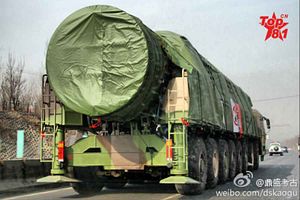During a discussion at the Carnegie Endowment for International Peace (44:20), Professor Li Bin, a nuclear strategist at Beijing’s Tsinghua University, said he didn’t believe that China had deployed MIRVs (multiple independently-targetable re-entry vehicles), but that “on one missile there is one real warhead and many decoys” and that these decoys are in fact “missile defense countermeasures.”
Li further speculated that “China wants to understand the technology,” suggesting that the People’s Republic is testing MIRV systems without actually having one ready for immediate use. He is personally against China deploying actual MIRVs because it would place Beijing “in a more dangerous situation” of “use or lose.” The decoys, however, would “not change strategic stability.”
Contrary to Li’s assertions, the U.S. Defense Department believes that China has in fact deployed MIRVs. In its latest annual report to Congress on China’s military capabilities, the Department claimed for the first time that China possessed MIRV-equipped nuclear weapons, specifically identifying China’s Dong Feng (DF)-5 ICBM missile. The newly developed DF-41 ICBM may be MIRV-equipped as well.
Hans M. Kristensen of the Federation of American Scientists writes that MIRV missiles “deliver two or more warheads against different targets,” potentially hitting “targets separated by over 1,500 kilometers.”
Because the most prominent feature of a nuclear arsenal is its total number of missiles, MIRVs serve as a way for nuclear powers to obscure the number of locations they might threaten with nuclear strikes. This makes even a small number of missiles into an immediate existential threat to other countries.
Li seems to be suggesting China’s MIRV decoys would misdirect an opponent’s missile defense systems, increasing the likelihood of the real warhead hitting its target. This would be in response to China’s perceived threat of U.S. missile defense systems.
It may, however, be impossible for China’s opponents to distinguish between decoy MIRVs designed to fool missile defenses and the genuine article, making China’s development of decoy MIRVs appear aggressive. Simply insisting that the systems are decoys would do little to mitigate this, which is why I believe the perception that China has MIRVs, whether real or decoy, will have a significant impact on the strategic balance. In other words, the other major powers and their allies, including the United States, Russia, and India among others, will take steps to counter the perceived change of balance.
According to the 2014 U.S. report, “China’s new generation of mobile missiles, with payloads consisting of Multiple Independently Targeted Reentry Vehicles (MIRVs) and penetration aids, are intended to ensure the viability of China’s strategic deterrent in the face of continued advances in U.S. and, to a lesser extent, Russian strategic ISR, precision strike, and missile defense capabilities.”
In this sense, the United States and China agree that China’s potential MIRVs are in response to U.S. missile defense. The question of whether they make a devastating loss more likely or in fact threaten even greater destruction is one that both countries and the entire world will take very seriously.
Li, a professor of Sino-U.S. relations specializing in nuclear issues, is currently in the United States as a senior associate with the Carnegie Endowment. The talk took place on Thursday, May 5 in Washington, D.C.
































